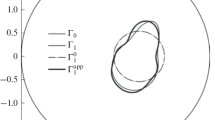Abstract
A method which can account for body tissue resistivity and anisotropy in studies of the heart-lead relation has long been desired. This paper describes a twice-life-size analogue model which mimics the resistive properties of heart muscle, heart-blood cavities, great vessels, lung, liver, fat, anisotropic skeletal muscle, ribs and spine. Although designed for electrocardiographic studies, its use for impedance plethysmographic investigation is equally suitable. The exterior boundary can be employed with or without the internal analogue structure to emphasize effects specifically associated with the inhomogeneities and anisotropies of the thoracic tissues.
The technique for model construction combines two established methods of field investigation; the electrolytic tank and the resistive network. A matrix of interlocking plastic rods immersed in the conducting fluid constrains the current flow so as to create the desired resistor network within the electrolytic tank. The electrical instrumentation, which consists of a pulsed bridge with a storage-oscilloscope null detector, has several advantages over conventional measurement techniques and is also described in the paper.
Sommaire
On recherche depuis longtemps une méthode adaptable aux études d'anissotropie et de résistivité des tissus en relation avec le coeur. Cet article décrit un modèle analogue, deux fois plus grand que nature, imitant les propriétés de résistivité du muscle cardiaque, des cavités cardiaques des grands vaisseaux, des poumons, du foie, des couches grais euses, du muscle anisotropique squelettique, des côtes et de la colonne vértébrale. Bien que conçu en vue de faciliter les études d'électrocardiographie, son utilisation se prête aussi à l'examen pléthysmographique de l'impédance. Ses limites externes peuvent être employées avec ou sans structure analogue interne dans le but de souligner les effets spécifiquement associés avec les non-homogénéités et les anisotropies des tissus thoraciques.
La technique employée pour la construction du modèle combine deux méthodes éprouvées d'investigation de champ: le tank électrolytique et le réseau de résistance. Une matrice en tiges assemblées en mailles et an matière plastique immergée dans le fluid conductif contraint le débit pour créer le réseau de résistances désiré à intérieur du tank électrolytique. L'instrument de contrôle ĺectrique qui consiste en un shunt pulsé avec un détecteur de zéro à oscilloscopemèmoire possède de nombreux avantages sur les techniques classiques de mesure et fait ici l'objet d'une description.
Zusammenfassung
Ein Verfahren, das spezifischen Widerstand der körperlichen Gewebe und die Anisotropie bei Untersuchungen der Herz-Zuleitung Beziehung erklären kann, ist seit langer Zeit erwünscht worden. Dieser Bericht beschreibt ein doppellebensgrosses Analogmodell, das die Widerstandseigenschaften des Herzmuskels, Herz-Bluthöhlen, grosse Gefässe, Lunge, Leber, Fett, anisotropischen Skelettmuskel, Rippen und Rückgrat nachahmt. Obwohl es für elektrokardiographische Untersuchungen entworfen wurde, ist es ebenso für plethysmographische Impedanzuntersuchungen geeignet. Die äussere Umgrenzung kann mit oder ohne den inneren Analogaufbau benutzt werden, um speziell die Wirkungen hervorzuheben, die mit den inhomogenen und anisotropischen Erscheinungen der Brustgewebe verbunden sind.
Die Technik des Modellaufbaus kombiniertzei bestehende Verfahren der Felduntersuchung: der elektrolytische Tank und das Widerstandsnetzwerk. Eine Matrix von miteinander verknüpften plastis chen Stäben, die in die leitende Flüssigkeit getaucht sind, bindet den Strom in einer Art, um das gewünschte Widerstandsnetzwerk innerhalb des elektrolytischen Tanks zu bilden. Die elektrische Instrumentierung, die aus einer Impulsbrücke mit einem Nullinstrument-Speicheroszillograph besteht, hat verschiedene Vorteile vor den üblichen Messverfahren und wird auch in dem Bericht beschrieben.
Similar content being viewed by others
References
Barr, R. C., Pilkington, T. C., Boineau, J. P. andSpach, M. S. (1966) Determining surface potentials from current dipoles, with application to electrocardiography.IEEE Trans. bio-med. Engng 13, 88–92.
Bayley, R. H. andBerry, P. M. (1965) Changes produced in the resultant heart vector by the non-homogeneous volume conductor with normal specific resistivities. In:Proc. Long Island Jewish Hosp. Symp. Vectorcardiogr., pp. 109–118. North Holland, Amsterdam.
Brody, D. A. (1956) A theoretic analysis of intracavitary blood mass influence on the electrocardiogram.Circulation Res. 4, 731.
Burger, H. C. andvan Milaan, J. B. (1947) Heartvector and leads—II.Br. Heart J. 9, 154–160.
Einthoven, W., Fahr, G. andDe Waart, A. (1950) On the direction and manifest size of the variations of potential in the human heart and on the influence of the position of the heart on the form of the electrocardiogram.Am. Heart J. 40, 163–211.
Eycleshymer, A. C. andSchoemaker, D. M. (1911). In:A Cross-Section Anatomy. Appleton-Century Crofts, New York.
Frank, E. (1957) Spread of current in volume conductors of finite extent.Ann. N. Y. Acad. Sci. 65, 980–1001.
Gelernter, H. I. andSwihart, J. C. (1963) Numerical computation of generators in the heart.Proc. Int. Conf. Cardiac Electrophysiol. Milan.
Hohl, J. andRush, S. (1968) Complete heart lead relation for the Einthoven triangle.Bull. math. Biophys. 30, 615–623.
Karplus, W. J. (1958) In:Analogue Simulation, Chap. 7. McGraw-Hill, New York.
Liebmann, G. (1950) Solution of partial differential equations with a resistance network analogue.Br. J. appl. Phys. 1, 92–103.
McFee, R. andJohnston, F. D. (1953) Electrocardiographic leads. I. Introduction.Circulation 8, 554–568.
McFee, R. andParungao, A. (1961) An orthogonal lead system for clinical electrocardiography.Am. Heart J. 62, 93–100.
McFee, R. andRush, S. (1967) Qualitative effects of thoracic resistivity variations on the interpretation of electrocardiograms: the ‘Brody’ effect.Am. Heart J. 74, 642–651.
McFee, R. andRush, S. (1968) Qualitative effects of thoracic resistivity variations on the interpretation of electrocardiograms: The low resistance surface layer.Am. Heart J. 76, 48–61.
Okada, R. H. (1956) Potentials produced by an eccentric current dipole in a finite-length circular conducting cylinder.I.R.E. Trans. med. Electron. 7, 14–19.
Rush, S., Abildskov, J. A. andMcFee, R. (1963) Resistivity of body tissues at low frequencies.Circulation Res. 12, 40–49.
Rush, S., Turner, A. H. andCherin, A. H. (1966) Computer solution for time-invariant electric fields.J. appl. Phys. 37, 2211–2217.
Rush, S. (1967a). A principle for solving a class of anisotropic current flow problems and applications to electrocardiography.IEEE Trans. bio-med. Engng 14, 18–22.
Rush, S. (1967b) In:Proc. Ann. Conf. engng Biol. Med. 9, 21. IEEE, New York.
Schwan, H. P. (1957) Discussion: Part IV.Ann. N.Y. Acad. Sci. 65, 1069–1071.
Author information
Authors and Affiliations
Rights and permissions
About this article
Cite this article
Rush, S. An inhomogeneous anisotropic model of the human torso for electrocardiographic studies. Med. & biol. Engng. 9, 201–211 (1971). https://doi.org/10.1007/BF02474815
Received:
Issue Date:
DOI: https://doi.org/10.1007/BF02474815




